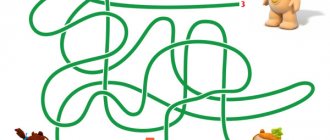Voluntary attention is the process of focusing attention on a specific object using volitional efforts. Already from the definition it is clear that for a preschooler this is a very difficult task that requires significant stress. Voluntary attention involves the volitional sphere, which at this age is still developing. However, all school learning is based on the arbitrariness of cognitive processes. Therefore, voluntary attention must be developed starting from preschool age.
Psychological characteristics of senior preschool age
Preschool childhood is a very unique period of human development. The period boundaries are from three to seven years. This long period is divided into two stages. The first is the stage of junior preschool age (from 3 to 5 years), and the second is the stage of senior preschool age (from 5 to 7 years).
At this age, the child’s entire mental life and his attitude to the world around him are restructured. The essence of this restructuring is that in preschool age the inner life of the soul and internal behavioral regulation are formed.
In preschool age, under the influence of training and upbringing, intensive development of all cognitive mental processes occurs.
Memory. Preschool age is the most favorable age for memory development. Memory becomes the dominant function. The child easily remembers a variety of materials.
Memory development moves from involuntary and direct to voluntary and mediated recall and reminder. In middle preschool age (4 to 5 years), voluntary memory begins to form.
Memory, which is more and more connected with speech and thought, becomes intellectual, elements of verbal-logical memory are formed.
Think. Thinking in preschool age is characterized by a transition from visual-actual to visual-imaginative and at the end of the period to verbal thinking. However, the main type of thinking is visual-imaginative. A preschooler thinks figuratively, but has not yet mastered the logic of thinking of an adult. He/she solves mental problems in the representation and his/her thinking becomes extra-situational. Conditions are created for such mental qualities as independence, flexibility and curiosity. There are attempts to explain phenomena and processes. Children's questions are indicators of the development of curiosity.
Address. At the age of seven, language becomes a means of communication and thinking for a child, as well as an object of conscious learning, since learning to read and write begins in the process of preparing for school. According to psychologists, the language really becomes native to the child.
The phonetic side of the language is developing. Younger preschoolers learn about the idiosyncrasies of their pronunciation. By the end of preschool age, the process of phoneme development is complete. The child's vocabulary is growing rapidly. The grammatical structure of the language develops. Children learn the subtlest patterns of morphological order (word structure) and syntax (sentence structure). The child learns grammatical forms of speech and actively expands his vocabulary, which allows him to move on to contextual speech at the end of preschool. He can retell a story or fairy tale he has read, describe a picture, convey his impressions of what he saw.
Perception. Perception in preschool age loses its original affective character: perception and emotional processes differ. Perception becomes meaningful, focused and analytical. It prescribes voluntary actions - observation, consideration, search. Language has a significant influence on the development of perception at this time - the child begins to actively use the names of qualities, characteristics, states of various objects and relationships between them.
Attention, its types, functions and properties
Attention is attention. This is connected with the interests and talents of the child; his properties depend on such qualities: Observation, the ability to notice subtle but significant features in objects and phenomena. Attention is one of the main conditions for successful reception
availability for him of the volume of knowledge, skills and establishing contact with adults. In the absence of attention, a child cannot learn to imitate the actions of an adult, nor act according to a model, nor follow verbal instructions. The development of attention is closely intertwined with the development of memory.
The preschooler's attention reflects his interests in relation to surrounding objects and actions performed with them. The child focuses on an object or action only until his interest in that object or action wanes. The appearance of a new subject causes a shift in attention, so that children rarely engage in the same activity for a long time.
The main types of attention are: natural and socially conditioned attention, direct and indirect attention, sensory and intellectual attention, involuntary, voluntary and post-procedural attention.
Natural attention is paid to a person from birth as an innate ability to selectively respond to specific external or internal stimuli that carry elements of information novelty. The basic mechanism that allows this attention to function is called the orienting reflex. Socially conditioned attention is formed throughout life through training and education and is associated with the volitional regulation of behavior, with a selective conscious reaction to objects.
Direct attention is not controlled by anything other than the object to which it is directed and which corresponds to the actual interests and needs of the person. Indirect attention is controlled by specific means, for example, gestures, words, prompts, objects.
Sensory attention is associated with emotions and the selective work of the senses, intellectual attention is associated with concentration and direction of thoughts. With sensory attention, the sensory impression is at the center of consciousness, and with intellectual attention, the object of interest is thought.
Voluntary (intentional) attention is attention that is consciously directed and regulated. This is associated with volitional efforts and, as a rule, depends on the specific goal set.
Speech as the main means of developing voluntary attention
The word acts as a means of organizing attention. The preschooler listens to the adult’s request or instruction and takes appropriate actions. In this case, it is the voluntary function of attention that is fully involved. First of all, the child has to listen to what he is told, and then redirect his attention directly to actions and objects (“bring the blue cup”, “first place the large cubes, and then the smaller ones on top of them”, etc.).
Speech is the most effective means of directing the attention of a preschooler. In early preschool age, the words spoken by an adult essentially serve as instructions to the child where to look, what to listen to, how to turn, etc. And at first they have the simplest forms: “watch what I do,” “take the green ones.” circles”, “feel how prickly the Christmas tree’s needles are.”
But every year a preschooler can capture more and more attention. Therefore, multi-step instructions and orders are feasible for him to assimilate. For example, a teacher teaches a child how to paint with watercolors: “Each time, dip the brush in water and then in paint - this way the paint will adhere better to the sheet. And be sure to wash your brush before using paint of a different color.” This is an algorithm that should be used constantly when drawing. And the child copes with this.
The more fully a preschooler himself masters speech, the more his opportunities for volitional choice of objects to which he will pay attention in turn expand. Many children willingly talk about how they will do one thing first, then watch another, etc. This means that they independently use the word to control attention.
Adults should encourage the child to tell him what he is doing, what he wants to draw or build. This simple method will allow the preschooler not to be distracted and to complete his small task.
The speech skills of older preschoolers allow them to purposefully pay close attention to individual objects and phenomena, as well as to the sphere of social relations. They ask questions of adults, perhaps out of fleeting interest in something. However, the answer they receive can spark further interest, and preschoolers focus their attention to learn even more.
Characteristics of voluntary attention
The basis of voluntary attention is the control of the intended goal. This type of attention is unthinkable without a certain effort of will on the part of the individual and its formation in the process of activity. This gave rise to the second name - voluntary attention (active, intentional).
When a person decides to engage in a certain type of activity, he realizes this intention by consciously directing his attention to something that may not interest him. However, to achieve this goal it is necessary to participate in it. The main function of volitional attention is the highly active direction of the course of psychological processes.
Accordingly, the determinants of voluntary attention are not biological, but social indicators. This type of attention is not formed in the child’s body, but develops in the process of interaction with adults. Despite the obvious differences from involuntary attention, voluntary attention is impossible without emotions, interests and life experience.
Regardless of the difference between voluntary and involuntary attention, they do not need to be separated and opposed. Involuntary attention develops from involuntary attention, and one cannot simply develop voluntary attention. The basis of its formation includes the following components:
- Interests,
- child's wishes,
- hobby.
The guiding function of voluntary attention is represented by the active regulation of the course of mental processes. Researchers have focused on the phenomenon of voluntary attention as an activity aimed at regulating behavior and maintaining stable selective activity.
Features of voluntary attention
For preschool age, the most important thing is purposefulness of attention. It is determined by the tasks that a person begins to set for himself in a particular activity. This is also the organized nature of the activity, when a preschooler expresses a desire to pay attention to a specific subject.
The child consciously sets goals and activates the mental processes necessary to achieve them. He begins to maintain his attention over a long period of time and defines activities by tasks or plan through which he expresses his intentions.
Reasons determining voluntary attention:
- The interests of the child that motivate him to participate in this activity;
- The concept of duty and obligation, which claims the need to perform a certain type of activity as efficiently as possible;
- Formation of voluntary attention, reflecting the orientation of the interests of the individual and denoting his personal and volitional qualities.
Already A.A. Ukhtomsky wrote that involuntary attention is “managed” (managed) by objects in the external world, and the “master” of voluntary attention is the personality of an adult or child.
From simple to complex: 8 ways to develop attention in a child
From simple to complex: 8 ways to develop attention in a child
How to develop and train the attention of a preschooler so that he can concentrate on a subject without being distracted by extraneous factors? We offer several ways.
discuss in the cerebral palsy community
memory, attention, child development, childhood psychology, cerebral palsy, cerebral palsy, cerebral palsy and other paralytic syndromes
Attention is one of the unique properties of the human psyche. Without it, it is impossible to achieve success in play, study and sports. This is why it is so important to develop attention from an early age.
Encyclopedic reference Attention is distinguished by external and internal manifestations. Signs of external manifestations: tense posture and concentrated gaze. Signs of internal manifestations of attention: increased heart rate and breathing, release of adrenaline in the blood.





